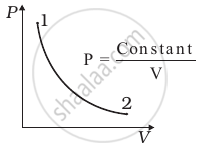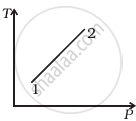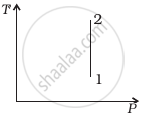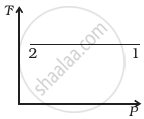Advertisements
Advertisements
Questions
Explain the cyclic process.
Explain cyclic process with the help of neat and labelled p-V diagram.
Solution
- A thermodynamic process that returns a system to its initial state is a cyclic process.
- In this process, the initial and the final state is the same.
- For a cyclic process, the total change in the internal energy of a system is zero. (ΔU = 0).
- According to the first law of thermodynamics, we have, for a cyclic process, Q = W
- The given figure shows the p-V diagram of a cyclic process which is a closed-loop.

p-V diagram of cyclic process - Working of all heat engines is a cyclic process.
APPEARS IN
RELATED QUESTIONS
Draw a p-V diagram of the irreversible process.
Draw a p-V diagram showing positive work with varying pressure.
State the assumptions made for thermodynamic processes.
3 mole of a gas at temperature 400 K expands isothermally from an initial volume of 4 litres to a final volume of 8 litres. Find the work done by the gas. (R = 8.31 J mol-1 K-1)
Write a note on free expansion.
Explain the thermodynamics of the isochoric process.
When a cycle tyre suddenly bursts, the air inside the tyre expands. This process is ____________.
Give the equation of state for an isothermal process.
Give an expression for work done in an isothermal process.
Apply first law for an isothermal process.
Apply first law for an adiabatic process.
Give the equation of state for an adiabatic process.
Give an equation state for an isochoric process.
Draw the PV diagram for the isobaric process.
What is meant by a reversible and irreversible processes?
Derive the work done in an isothermal process.
Derive the work done in an adiabatic process.
A thermodynamic system undergoes cyclic process ABCDA as shown in the figure. The work done by the system is ______

An ideal gas is expanded isothermally from volume V1 to volume V2 and then compressed adiabatically to original volume V1. If the initial pressure is P1, the final pressure is P3 and net work done is W, then ____________.
An ideal gas is made to go from a state A to stale B in the given two different ways (see figure) (i) an isobaric and then an isochoric process and (ii) an isochoric and then an isobaric process. The work done by gas in the two processes are W1 and W2 respectively. Then,

In which of the following processes, beat is neither absorbed nor released by a system?
An ideal gas A and a real gas B have their volumes increased from V to 2V under isothermal conditions. The increase in internal energy ____________.
For an isothermal expansion of a perfect gas, the value of `(Delta "P")/"P"` is equal to ____________.
We consider a thermodynamic system. If `Delta"U"` represents the increase in its internal energy and W the work done by the system, which of the following statements is true?
Which of the following processes is reversible?
Consider P-V diagram for an ideal gas shown in figure.

Out of the following diagrams (figure), which represents the T-P diagram?
 (i) |
 (ii) |
 (iii) |
 (iv) |
When an inflated ballon is suddenly burst, why is the emerging air slightly cooled?
Explain how can a gas be expanded at constant temperature.
